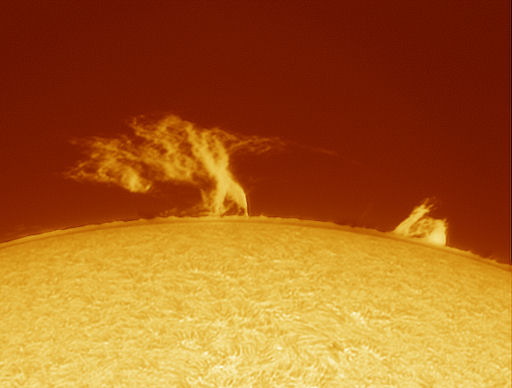
![]()
Solar wind
speed: 657.2 km/sec
density: 2.3 protons/cm3
explanation | more data
Updated: Today at 1526 UT
![]()
X-ray Solar Flares
6-hr max: C1 1248 UT Jul01
24-hr: C5 0716 UT Jul01
explanation | more data
Updated: Today at: 1500 UT
![]()
![]()
![]()
Daily Sun: 01 Jul 12
![]()
![]()
Sunspots 1513 and 1515 have 'beta-gamma' magnetic fields that harbor energy for M-class solar flares. Credit: SDO/HMI
![]()
![]()
![]()
Sunspot number: 90
What is the sunspot number?
Updated 01 Jul 2012
Spotless Days
Current Stretch: 0 days
2012 total: 0 days (0%)
2011 total: 2 days (<1%)
2010 total: 51 days (14%)
2009 total: 260 days (71%)
Since 2004: 821 days
Typical Solar Min: 486 days
Updated 01 Jul 2012
The Radio Sun
10.7 cm flux: 124 sfu
explanation | more data
Updated 01 Jul 2012
![]()
![]()
![]()
Current Auroral Oval:
![]()
Switch to: Europe, USA, New Zealand, Antarctica
Credit: NOAA/POES
![]()
![]()
![]()
Planetary K-index
Now: Kp= 3 quiet
24-hr max: Kp= 4 unsettled
explanation | more data
![]()
Interplanetary Mag. Field
Btotal: 5.2 nT
Bz: 3.6 nT north
explanation | more data
Updated: Today at 1527 UT
![]()
![]()
![]()
Coronal Holes: 30 Jun 12
![]()
![]()
Solar wind flowing from this coronal hole should reach Earth on July 2-3. Credit: SDO/AIA.
CHANCE OF MAGNETIC STORMS: NOAA forecasters estimate a 40% chance of polar geomagnetic storms today in response to a high-speed solar wind stream blowing around Earth. High-latitude sky watchers should be alert for auroras. Magnetic storm alerts: text, voice.
MASSIVE PROMINENCE: Amateur astronomers around the world are monitoring a massive, active prominence dancing along the sun's southeastern limb. Andre van der Hoeven sends this picture from HI-Ambacht, the Netherlands:
Prominences are filaments of magnetism filled with glowing-hot plasma. This beautiful "prom" rises more than 40,000 km above the stellar surface and stretches more than 20 Earth-diameters from end to end. Such structures are naturally unstable, and this one could collapse at any time. Keep and eye on the latest images for developments.
DARK HOLE IN THE SUN'S ATMOSPHERE: Ultraviolet telescopes onboard NASA's Solar Dynamics Observatory are monitoring a vast dark hole--a "coronal hole"--in the sun's upper atmosphere. It has just turned directly toward Earth:
Coronal holes are places where the sun's magnetic field opens up and allows the solar wind to escape. A stream of solar wind flowing from this particular gap is en route to Earth, due to arrive on July 2nd or 3rd. The impact could spark geomagnetic storms and auroras. Aurora alerts: text, voice.






